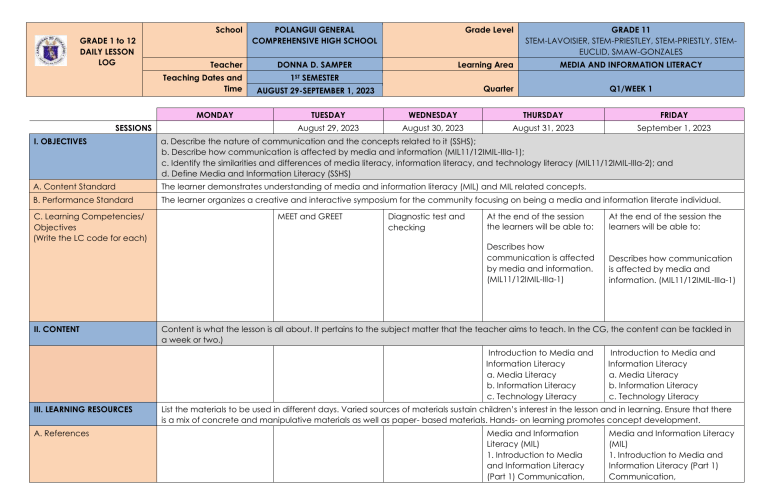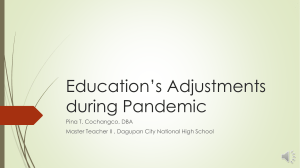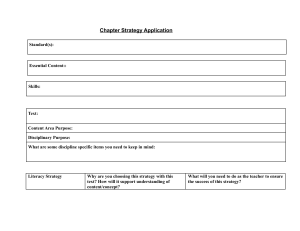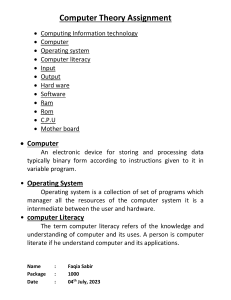
School GRADE 1 to 12 DAILY LESSON LOG Teacher Teaching Dates and Time MONDAY SESSIONS POLANGUI GENERAL COMPREHENSIVE HIGH SCHOOL Grade Level DONNA D. SAMPER Learning Area GRADE 11 STEM-LAVOISIER, STEM-PRIESTLEY, STEM-PRIESTLY, STEMEUCLID, SMAW-GONZALES MEDIA AND INFORMATION LITERACY 1ST SEMESTER Quarter AUGUST 29-SEPTEMBER 1, 2023 Q1/WEEK 1 TUESDAY WEDNESDAY THURSDAY FRIDAY August 29, 2023 August 30, 2023 August 31, 2023 September 1, 2023 I. OBJECTIVES a. Describe the nature of communication and the concepts related to it (SSHS); b. Describe how communication is affected by media and information (MIL11/12IMIL-IIIa-1); c. Identify the similarities and differences of media literacy, information literacy, and technology literacy (MIL11/12IMIL-IIIa-2); and d. Define Media and Information Literacy (SSHS) A. Content Standard The learner demonstrates understanding of media and information literacy (MIL) and MIL related concepts. B. Performance Standard The learner organizes a creative and interactive symposium for the community focusing on being a media and information literate individual. C. Learning Competencies/ Objectives (Write the LC code for each) II. CONTENT MEET and GREET Diagnostic test and checking At the end of the session the learners will be able to: At the end of the session the learners will be able to: Describes how communication is affected by media and information. (MIL11/12IMIL-IIIa-1) Describes how communication is affected by media and information. (MIL11/12IMIL-IIIa-1) Content is what the lesson is all about. It pertains to the subject matter that the teacher aims to teach. In the CG, the content can be tackled in a week or two.) Introduction to Media and Information Literacy a. Media Literacy b. Information Literacy c. Technology Literacy III. LEARNING RESOURCES A. References Introduction to Media and Information Literacy a. Media Literacy b. Information Literacy c. Technology Literacy List the materials to be used in different days. Varied sources of materials sustain children’s interest in the lesson and in learning. Ensure that there is a mix of concrete and manipulative materials as well as paper- based materials. Hands- on learning promotes concept development. Media and Information Literacy (MIL) 1. Introduction to Media and Information Literacy (Part 1) Communication, Media and Information Literacy (MIL) 1. Introduction to Media and Information Literacy (Part 1) Communication, 1. Teacher’s Guide pages Communication Models, Media Literacy, Information Literacy, Technology (Digital) Literacy, and MIL Communication Models, Media Literacy, Information Literacy, Technology (Digital) Literacy, and MIL Media and Information Literacy Teaching Guide Media and Information Literacy Teaching Guide unesco.org unesco.org 2. Learner’s Materials pages 3. Textbook pages 4. Additional Materials from Learning Resource (LR) portal B. Other Learning Resources IV. PROCEDURES These steps should be done across the week. Spread out the activities appropriately so that students will learn well. Always be guided by demonstration of learning by the students which you can infer from formative assessment activities. Sustain learning systematically by providing students with multiple ways to learn new things, practice their learning processes, and draw conclusions about what they learned in relation to their life experiences and previous knowledge, indicate the time allotment for each step. A. Reviewing previous lesson or presenting the new lesson The teacher does the getting The class reviews the concepts to know stage. that were discussed. B. Establishing a purpose for the lesson. Learner’s answer what they know about media. Ask the learners samples of mass media. C. Presenting examples/ instances of the new lesson D. Discussing new concepts and practicing new skills #1 The class define media. The The discuss the descriptions of learners accomplish the mass media. Then, the learners checklist about social media. are tasked to demonstrate how mass media affect communication through skits. E. Discussing new concepts and practicing new skills #2 F. Developing mastery (Lead to Formative Assessment) The learners match definition of words. The learners reflect on what they performed. G. Finding practical applications of concepts and skills in daily living Ask: How media affects communication? Ask: How media improved your communication skills? H. Making generalizations and abstractions about the lesson Learners give terms associated with media. Learners differentiate mass media objects. I. Evaluating Learning Learners write what media is for them. Learners write how media affects communication. J. Additional activities for application or remediation V. REMARKS Media and Information Literacy is taken twice (2) times a week by the learners with two (2) hour per meeting. VI. REFLECTION Reflect on your teaching and assess yourself as a teacher. Think about your students, progress this week. What works? What else needs to be done to help the students learn? Identify what help your instructional supervisors can provide for you so when you meet them, you can ask relevant questions. A. No. of learners who earned 80% in evaluation B. No. of learners who require additional activities for remediation who scored below 80%. C. Did the remedial lessons work? No. of learners who have caught up with lesson D. No. of learners who continue to require remediation E. Which of my teaching strategies worked well? Why did this work? F. What difficulties did I encounter which my principal or supervisor can help me solve? G. What innovation or localized materials did I use/ discover when I wish to share with other teachers? Prepared by: Noted: DONNA D. SAMPER ELSA E. RABANO Teacher I Assistant Principal II RANDY M. TADURAN




